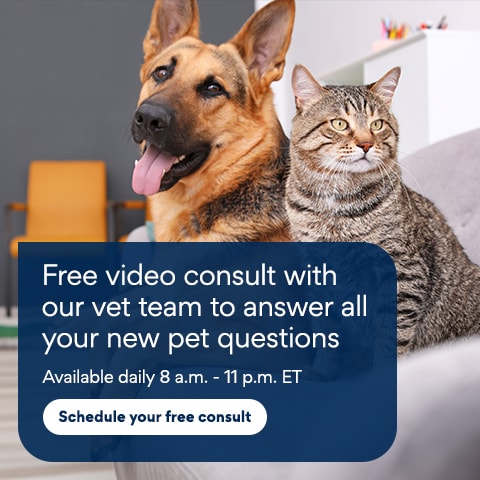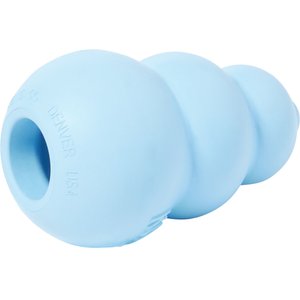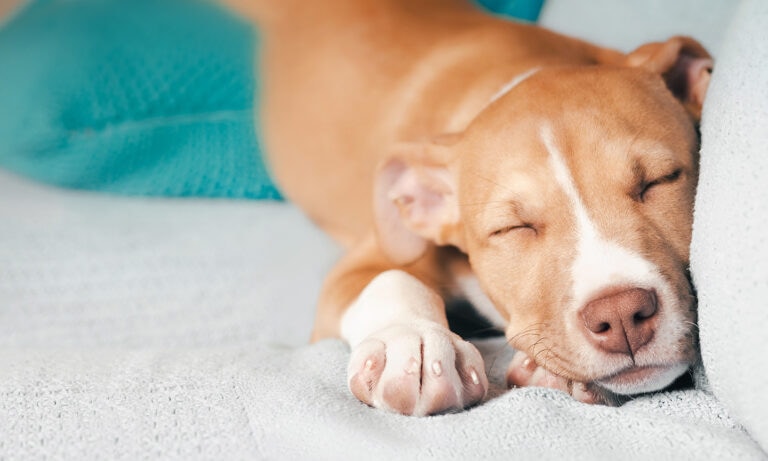"Seriously, when will my puppy stop teething?" said just about every dog parent ever. If your new puppy is 3 or 4 months old, you might be wondering when they will quit chewing on everything (their toys, your table, your shoes, your hand) and what, if anything, you can do to help them through it.
Puppy teething, or the process of developing healthy adult teeth, is crucial to your dog’s health. Here’s what you need to know about your puppy’s teeth, from ways to help them self-soothe (without destroying your favorite shoes) to when to call a veterinarian.
Click to jump to each section:
Puppy Teething Timeline
When Do Puppies Start Teething?
Newborn puppies’ first teeth begin to appear around 2-3 weeks of age—and you won’t have to work too hard to spot them. "The first teeth to appear are the incisors—the tiny teeth right in front," says Dr. Deb M. Eldredge, DVM, a New York–based veterinarian who retired from clinical practice and is the technical editor of Cornell DogWatch.
In total, puppies will develop 28 baby teeth (aka deciduous teeth, meaning they fall out).
Because many puppies are adopted after weaning from their mother, usually around 7 or 8 weeks old, many pet parents don’t witness newborn dog teething. Don’t worry: There’s another round of teething to come. "Puppies actually go through teething twice by the time they are 1 year old," Dr. Eldredge says.
Below is a chart that details when each type of baby teeth is expected to come in and fall out. Please note that not all puppies are the same. These are general guidelines, and your puppy’s teeth could begin coming in or falling out a little earlier or later than anticipated.
No teeth
Birth to 2 weeks old
n/a
Canines
3-5 weeks old
4-5 months old
Incisors
4-6 weeks old
3-5 months old
Premolars
5-6 weeks old
4-6 months old
When Do Puppies Lose Their Teeth?
While puppy teeth can begin to fall out (aka they start to lose their deciduous teeth) at 8 weeks of age, puppies typically begin to lose their teeth around 12-16 weeks, which is when their adult teeth—aka permanent teeth—begin to come in. As adults, they'll grow 14 more teeth, for a total of 42 teeth.
Most pups have their full set of adult teeth by 8 months of age or so.
When Do Puppies Stop Teething?
How long puppy teething lasts depends on your particular puppy. Expect puppy teething to last until your pup is 6-8 months. Some dogs—especially small and brachycephalic (short-nosed) breeds—might need help from a vet, if their baby teeth are resistant to falling out.
Types of Puppy Teeth
Puppies have three types of teeth:
- Canines: Puppies will have 12 canines. They are the long and pointed teeth located toward the front of your puppy’s mouth, behind the incisors. Canines are used for tearing.
- Incisors: Puppies will have four incisors. They are the small, flat teeth located at the front of your pup’s mouth and are used for scraping, nibbling and grooming.
- Premolars: Puppies will have 12 premolars, which are the sharp-edged teeth located behind the canines. Premolars are used for grinding and chewing.
Note that dogs do not get molars until their adult teeth come in.
Canines
6
6
Tearing
Incisors
2
2
Scraping, nibbling and grooming
Premolars
6
6
Grinding and chewing
Puppy Teething Symptoms
How can you tell if your puppy is teething? Once your pup is 3 or 4 months old, keep an eye out for these puppy teething symptoms:
- Blood on toys: Don’t freak out if you spot a little blood on your puppy’s fave chew toys—it’s normal and won’t hurt them.
- Dog-version of baby teeth: Just like with human babies, your fur babies teeth fall out as they begin the teething process—it’s normal. You may find them stuck to toys or whatever else they’ve been chewing. They lose 28 baby teeth (also called milk teeth) in all over a period—some you may see, others not.
- Increased chewing: Chewing is a natural instinct for dogs, but for many puppies, teething can put that impulse into overdrive. That’s because chewing can be a self-soothing behavior for teething puppies—but it can also put your belongings at risk. Below are some expert strategies to save your shoes.
Other puppy teething symptoms include:
- Increased drooling
- Hesitating to eat
- Eating slowly
- Whining
- Running a low fever
- Red and/or swollen gums
How To Help a Teething Puppy
Teething is an unavoidable rite of passage for puppies, but you can make things a little easier for your little furry friend. Here are five ways to help a teething puppy.
1. Provide Puppy Teething Toys
Puppies love to chew! Your best bet is to help them do it safely with a teething toy. Just be sure you’re in the room when the chewing happens: Toys for a teething puppy should only be used under your supervision, as sharp puppy teeth can rip off small chunks that your pup may then swallow.
Try these puppy teething toys:
- Soft rubber dental rings
- Soft plastic chews
- Teething sticks
- Bully sticks
Victoria Schade, CPDT-KA, author, dog trainer and owner of Frolic Pup in Doylestown, Pennsylvania, recommends the following teething toys:
- KONG Puppy toy: The rubber is designed specifically for a growing puppy’s baby teeth. "KONG rubber toys are usually my go-to suggestion for dogs of all ages, but particularly puppies because it’s a safe and fun busy toy," Schade says.
- KONG Puppy Teething Stick: "The grooves on the teething stick make it easy for them to get a quick payoff," she says.
Avoid the following:
- Plush toys: “Puppy teething toys should be tough enough to withstand hard chewing, which means that plush toys aren’t a good option,” says Schade.
- Your hands: Many puppies at this age are learning bite inhibition (aka the ability to control the strength of their bite). It’s important to put a stop to them biting your hands—even nips—before it escalates or becomes an ingrained behavior.
Here are some of the best puppy teething toys:
2. Provide Freeze Treats and Toys
Cold treats can ease the swelling and pain of tender teething gums. While ice cubes may be too rough on their teeth, frozen carrots cut into small, chewable chunks are an easy solution.
Another option: Freeze your puppy’s toys. Or better yet, freeze a treat inside their toy, like KONG’s Puppy Easy Treat, which pet parents can use to fill up their pup’s KONG toy and it’s gentle on sensitive stomachs.
3. Puppy-Proof Your Home
Your puppy wants to chew everything, including your shoes, sofa and lots of other things that will be aggravating to replace. Here are a few simple strategies from our experts to try:
- Hide personal possessions or put them out of reach. You pup is going to be especially drawn to anything that smells like you (their favorite thing in the world). Shoes on the floor of a closet, laundry in a basket, your phone on the couch— these items are simply too enticing for a teething puppy. Put them out of reach for safety and know that teething does not last forever.
- Protect electrical cords. Cords, whether electrical or from your blinds or curtains, that are on the floor or within reach, are another temptation for chewing. Move cords out of reach (upward, of course) or utilize tools such as cord covers if moving cords upward and out of reach is not an option.
- Install child-proof safety locks on drawers and cabinets. It might feel like overkill but installing child-proof safety locks on lower drawers in the kitchen can help prevent a chewing puppy from getting into foods or linens stored within.
- Provide a “safe” spot for your puppy to hang out. Use gates to close off rooms that you do not want them to explore and find fun things to chew on. The MidWest Steel Pet Gate, for example, can help keep teething pups in safe spaces and comes in two colors to blend in with your home’s decor.
4. Redirect the Behavior
Chewing is going to happen. Getting angry and scaring your pup is not a solution. Be prepared to distract them from gnawing on your prized possessions by providing appropriate toys under supervision such as those listed above.
Of course, accidents are going to happen. If you catch your pup chewing on your pricey pumps or sofa cushion, remove the item or remove them from the item and give them a firm “no,” replacing the item with a toy that is cool to chew on. Positive reinforcement will go a long way in teaching your puppy.
5. Start Them on the Road to Proper Dental Care
While for the moment you can skip the dog tooth brushing—yes, you will need to brush your dog’s teeth as part of their overall pet care—now is the time to start familiarizing your pup with elements of tooth brushing without actually scrubbing their (super-sensitive!) new teeth. You can do this by lightly touching the teeth with a toothbrush or putting dog toothpaste, such as TropiClean Fresh Breath Puppy Clean Teeth Gel, in their mouth. This will help put your pup on the road to good dental health, lowering their risk of future trouble like periodontal disease.
Shop Related Products on Chewy
When To Call Your Vet
For most puppies, teething is mildly uncomfortable—but routine. Sometimes, though, a call to the vet might be necessary. You’ll want to watch for these signs of teething troubles. If you spot these issues, give your vet a call.
- Trouble eating
- Rubbing at the mouth
- Dropping food from the mouth while eating
- Reluctance to eat or chew
- Odor from the mouth
Toy breeds, in particular, seem prone to "double teeth," says Dr. Eldredge, referring to when a baby tooth stays even though an adult tooth has also moved in. "The retained baby teeth can cause problems for the developing adult teeth. They may totally block the eruption of the adult tooth, leading to a very sore and swollen gum area," she says.
A vet might suggest removing deciduous teeth at the same time as a dog’s spay or neuter procedure, since they both require general anesthesia.
As a pet parent, you can help during this transition by providing appropriate dog toys, introducing dental health habits and watching out for signs of trouble. And if your couch or favorite shoes become a casualty of puppy teething, well, they weren’t nearly as cute as your adorable pup anyway.
FAQs About Puppy Teething
Q:
When do puppy teeth fall out?
Q:
Are puppies born with teeth?
Q:
What teeth do puppies lose?
Q:
When do puppies teethe the worst?
Q:
Do puppies experience sore gums?
Q:
Why are puppy teeth so sharp?
A:
Puppy teeth are sharp for a couple of reasons:
- Puppies have sharp teeth so they can learn to chew solid food.
- The sharp teeth help encourage gentle play. Puppies receive negative feedback from their playmates if they bite too hard during playtime, which in turn teaches them to moderate their biting.
There are no "stupid" questions when it comes to your pet’s health. If you suspect your pet is sick, please call your vet immediately. For health-related questions, always consult your regular veterinarian when possible as they can make the best recommendations for your pet.
What else can you expect to experience during your puppy’s first year? Read our puppy stages guide to learn more.
Expert input provided by veterinarians Dr. Jennifer Coates, DVM, a veterinarian consultant in Fort Collins, Colorado; Dr. Deb M. Eldredge, DVM, a New York–based veterinarian who retired from clinical practice and is the technical editor of Cornell DogWatch; Dr. Sabrina Kong, DVM, a vet at a small animal clinic in Northern California and a veterinary consultant for We Love Doodles; Dr. Sara Ochoa, DVM, a veterinarian at Animal Hospital of West Monroe in West Monroe, Louisiana, and the co-founder of How To Pets; and Victoria Schade, CPDT-KA, author, dog trainer and owner of Frolic Pup in Doylestown, Pennsylvania.
Additional reporting by Laura Willard.
More on caring for a puppy:
Share:
















